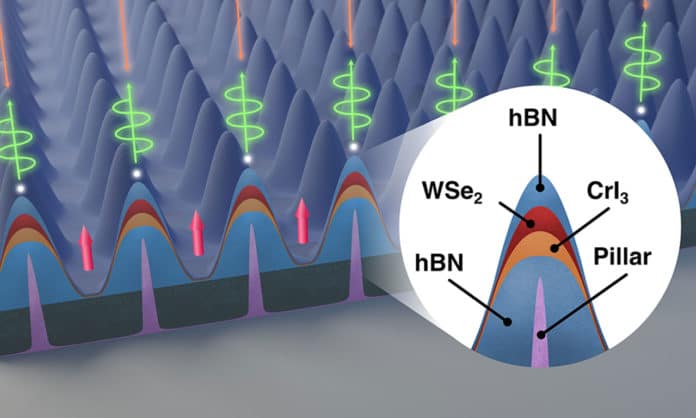Photonic integrated circuits are advancing state-of-the-art quantum and classical information processing due to desirable properties like high operating speeds and low energy consumption.
Scientists from the University of Rochester and Cornell University have taken a significant step toward developing a communications network that exchanges information across long distances by using photons. They have designed a nanoscale node using magnetic and semiconducting materials. The node can interact with other nodes, using laser light to emit and accept photons.
This newly designed node is composed of an array of pillars that are 120 nanometers high. These pillars contain atomically thin layers of semiconductors and magnetic materials.
The array is designed so every pillar fills in as a location marker for a quantum state that can interface with photons. The related photons can conceivably cooperate with different locations over the device and parallel arrays at various locations. This possibility to interface quantum nodes over a remote network capitalizes by the idea of entanglement.
Nick Vamivakas, professor of quantum optics and quantum physics at Rochester, said, “This is the beginnings of having a kind of register if you like, where different spatial locations can store information and interact with photons.”
Scientists developed the device using a novel alignment of WSe2 draped over the pillars with an underlying, highly reactive chromium triiodide (CrI3). Where the atomically thin, 12-micron area layers touch, the CrI3 imparts an electric charge to the WSe2, creating a “hole” alongside each of the pillars.
When the device is bathed in laser light, further reactions happen, transforming the nanomagnets into individual optically active spin arrays that emit and interact with photons. Unlike classical information that process in the form of bits- 0 or 1, the spin states can encode both 0 and 1 simultaneously, growing the opportunities for information processing.
Lead author and graduate student Arunabh Mukherjee said, “Being able to control hole spin orientation using ultrathin and 12-micron large CrI3, replaces the need for using external magnetic fields from gigantic magnetic coils akin to those used in MRI systems. This will go a long way in miniaturizing a quantum computer based on single hole spins.”
While developing the device, scientists address two significant problems:
1. Creating an inert environment in which to work with the highly reactive CrI3.
2. Determining just the right configuration of pillars to ensure that the holes and spin valleys associated with each pillar could eventually be properly registered to link to other nodes.
And therein lies the next major challenge: finding a way to send photons long distances through an optical fiber to other nodes while preserving their entanglement properties.
Vamivakas says, “We haven’t yet engineered the device to promote that kind of behavior. That’s down the road.”
Other coauthors of the paper include lead authors Kamran Shayan of Vamivakas’ lab and Lizhong Li, Jie Shan, and Kin Fai Mak at Cornell University.
Journal Reference:
- Arunabh Mukherjee et al. Observation of site-controlled localized charged excitons in CrI3/WSe2 heterostructures. DOI: 10.1038/s41467-020-19262-2
